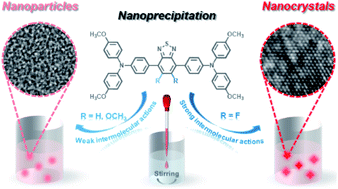Facilely prepared aggregation-induced emission (AIE) nanocrystals with deep-red emission for super-resolution imaging†
Abstract
Organic nanocrystals (NCs) with high brightness are highly desirable for biological imaging. However, the preparation of NCs by a facile and fast method is still challenging. Herein, an aggregation-induced emission (AIE) luminogen of 4,4′-(5,6-difluorobenzo[c][1,2,5]thiadiazole-4,7-diyl)bis(N,N-bis(4-methoxyphenyl)aniline) (DTPA-BT-F) in the deep-red region is designed with intensive crystalline features to obtain NCs by kinetically controlled nanoprecipitation. The prepared AIE NCs with high brightness and good photo-stability are then applied in super-resolution imaging via stimulated emission depletion (STED) nanoscopy. As observed, the nanostructures in lysosomes of both fixed and live cells are well visualized with superior lateral resolutions under STED nanoscopy (full width at half maximum values, 107 and 108 nm) in contrast to that in confocal imaging (548 and 740 nm). More importantly, dynamic monitoring and long-term tracking of lysosomal movements in live HeLa cells, such as lysosomal contact, can also be carried out by using DTPA-BT-F NCs at a superior resolution. To the best of our knowledge, this is the first case of AIE NCs prepared by nanoprecipitation for STED nanoscopy, thus providing a new strategy to develop high performance imaging agents for super-resolution imaging.



 Please wait while we load your content...
Please wait while we load your content...